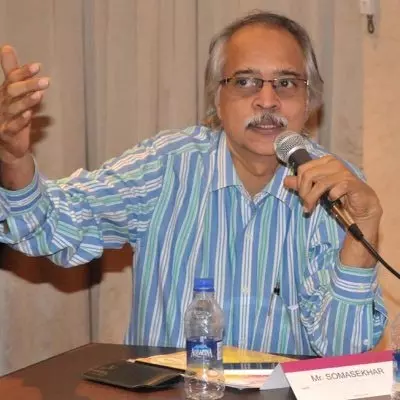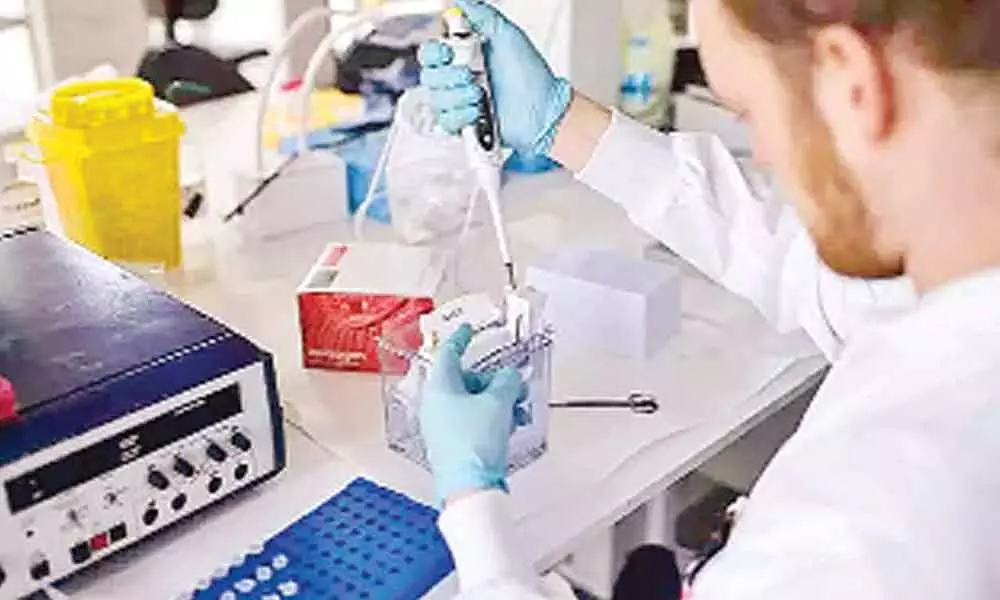Live
- Creative child centre Summer camp closing ceremony - 2024
- Samantha inspires with her fitness transformation
- China support for Russia crucial to course of Ukraine war: NATO
- ‘Ranganayaki’ for ‘AAY’ sounds energetic
- Sundeep Kishan, Aparna Balamurugan sizzle in AR Rahman’s melodic treat for Dhanush’s ‘Raayan’
- Balakrishna unveils ‘Satyabhama’ trailer amidst grand event
- ‘Bhaje Vaayu Vegam’ creates buzz with trailer launch event
- BJD will form stable govt, says Naveen
- Bangladesh 'hopeful' of Taskin Ahmed's return for T20 World Cup opener against Sri Lanka
- Ban Fake Seeds, Take Action Against Price Gouging Dealers; Farmers union
Just In
Health infra development, an absolute must in Telangana


Health infra development, an absolute must in Telangana
Known for his bold, sometimes dismissive and practical remarks on the ongoing Covid - 19 pandemic, Telangana State Chief Minister K Chandrasekhar Rao made a strong plea for urgent steps to beef up public health infrastructure in India to face present and future challenges.
Known for his bold, sometimes dismissive and practical remarks on the ongoing Covid - 19 pandemic, Telangana State Chief Minister K Chandrasekhar Rao made a strong plea for urgent steps to beef up public health infrastructure in India to face present and future challenges.
He urged Prime Minister, Narendra Modi to focus on ramping up healthcare infrastructure from the lessons of handling the coronavirus pandemic so far during a video conference on August 12 in which 10 Chief Ministers took part.
Going by sheer data provided by various governments, though the absolute number of cases is climbing rapidly crossing 35 lakh as on date, the recovery and mortality percentages claimed are among the best when compared to the US, UK, Brazil, Spain etc. This, despite harrowing tales of patients & families going through agony and hospitals/doctors caught woefully short of protective gear and beds to fight the COVID19 pandemic.
The Telangana story
In the five months since lockdown, Telangana State has not covered itself with much glory as far as its transparency, preparedness and a firm strategy to control the pandemic is concerned. Neither has it tested adequately nor has it been forthcoming in giving relevant & timely information to boost public confidence. These aspects have been clearly echoed by Doctors Forum, media and even the Prime Minister asking the State govt to step up testing.
In the beginning phase of March, the State govt was a bit dismissive saying that the virus dare not enter Telangana and if it did will easily handle it. Once the numbers stared climbing, it said govt hospitals were equipped to take care. As criticism started growing, it announced converting a large 1000-plus room complex in Gachibowli Stadium complex into a hospital- Telangana Institute of Medical Sciences & Research (TIMS).
But, gaping holes started appearing in the statements, as doctors at the Gandhi Hospital, the main Covid treatment centre went on strike demanding more protective equipment and safety from patients' families too. Next, scenes of wards flooded with water in the Osmania General Hospital exposed the state of affairs.
Healthcare infrastructure in Telangana
According to the healthcare index rankings (overall performance) of NITI Aayog for 2018, announced in mid 2019, Telangana was 10th among the 21 larger states surveyed. Kerala was number 1 and Uttar Pradesh was last. Telangana finds itself at the bottom among the five southern states.
The NITI Aayog, indicated that the overall performance of the State in various sectors of healthcare have been average. The situation was worse in indicators like low birth weight of newborns, availability of 24/7 facilities in the 74 PHCs or heart care units in districts.
Some news to cheer was the improvement in Neonatal Mortality Rate (NMR) and general health of under 5 year old. The State had improved its performance in Governance and data integrity as far as reporting was concerned and least deviation between State and Central programmes.
Nonetheless, the State's tertiary care is not only understaffed but also outnumbered to cater to the patients. With one chest hospital, one mental health hospital, and one cancer hospital, specialised treatments are hard to find.
Even tertiary care centres in Hyderabad are ill-equipped, with an acute lack of medical infrastructure and healthcare professionals, with doctors and nurses working at almost 50 per cent of personnel capacity, it observed.
Healthcare budgets
In Telangana, there has been a steady dip in allocations to health in successive budgets. In 2018-19, it accounted for 3.9 per cent or Rs 5,976 crore of the Rs 1.49 lakh crore Budget. In 2019-20, it dropped to 3 per cent or Rs 5,536 crore of the estimated Rs 1.82 lakh crore Budget (later downsized to Rs 1.46 lakh crore due to fall in revenues). In 2020-21, the State allocated Rs 6,186 crore of the estimated Rs 1.82 lakh crore Budget.
Even at the Centre, the allocation to health has been slowly increased in the successive Union Budgets, it accounts to around 1.4 per cent of the GDP, way short of the required minimum of 2.5 per cent. And only about 20 percent are covered by some sort of insurance.
Existing infrastructure
The twin cities of Hyderabad and Secunderabad are fortunate to have a string of nearly a dozen large, public funded hospitals. Of these, nearly eight are from the Nizam's contributions and British period. For example, the Gandhi Hospital, Secunderabad was started in 1861 and has grown into a large, modern hospital and teaching Centre. At present, it is the nodal, treatment centre for Covid-19 patients in Telangana.
In Hyderabad, the century old, Osmania General Hospital, now in a pathetic state, Fever Hospital, Niloufer paediatric, Maternity, King Koti and specialised ones like Chest, MNJ Cancer, ENT, Institute of Mental Health, Nizam's Orthopaedic, SD Eye and alternate systems like Unani, Ayurveda and Homeopathy, were all established pre-Independence and many during the time of the last Nizam of Hyderabad, Mir Osman Ali Khan.
These and the likes of the MGM Hospital in Warangal, catered to the predominantly communicable diseases and needs of the population for decades. From the 1980's, the situation started changing and the govt policies were slowly tuned in to encourage private sector entry. Consequently, a proliferation happened in private practitioners, nursing homes and gradually to corporate hospitals.
Growth in private sector and medico- entrepreneurship
The rapid growth led by chains like Apollo also gave rise to medico-entrepreneurs and saw the rise of CDR, CARE, Mediciti, LVPEI, Yashoda, Global, KIMS, AIG, Medwin, Sunshine, Continental, MaxCure to many mid-sized ones. In the last decade, multinational groups from Malaysia and investors from the a Gulf and US have invested too to bring the ' best in class' healthcare facilities in Hyderabad.
With the growth of the private sector, specially triggered during the rule of the Telugu Desam Party (1983-89) led by Chief Minister, NT Rama Rao, the govt infrastructure of hospitals and Primary Health Care (PHCs) in rural areas got impacted both in terms of qualified manpower, latest medical facilities and stagnant or little increase in budgetary allocations. With a cap on medical colleges and lure to go abroad, the domestic healthcare suffered.
Around 1986, the Andhra Pradesh Vaidya Vidhana Parishad was conceptualised to be a bridge between the large government hospitals and PHCs. It envisaged building a chain of 100-bed, tertiary care hospitals across Andhra Pradesh. The idea got a big boost with World Bank funds. Between 1995-2002, nearly 160 hospitals were established, of these 103 are in Telangana.
The trouble with a majority of the healthcare infrastructure in Telangana today is a shortage of manpower, qualified doctors and latest equipment. Except for a score of PHCs, many are in a pathetic situation. The net result has been the over dependence on Hyderabad for medical needs.
Expectedly, the private sector gradually monopolised healthcare in non-communicable diseases, built multispeciality facilities that gave returns on investment and profits too. The govt stuck to communicable diseases like TB, malaria, water borne diseases and public health matters. It only upgrades the Nizam's Institute of Medical Sciences, Gandhi Hospital and established the Rajiv Gandhi Institute of Medical Sciences in Adilabad etc. An All India Institute of Medical Sciences (AIIMS) type facility is coming up in Bibinagar on the outskirts of Hyderabad.
Though, Telangana can take pride that Hyderabad has emerged as the medical capital of the country, a vast majority of the other 32 districts are facing severe issues of shortages and desperately need strengthening. The struggles in the ongoing Covid- 19 situation is a grim lesson of this stark reality. It's common to hear experiences of high billing in private sector to neglect in govt hospitals.
Therefore, the Chief Minister has his job cut out, to first turn his wise counsel of building strong healthcare to improve the qualify of life of people of Telangana across districts by a strategy that involves, increasing budgets, recruiting doctors and other medical professionals, latest equipment and training and increasing medical college seats to cater to the growing demands.
Schemes like Kanti Velugu (eye care), KCR Kits, Basti Dawakhanas on the lines of Delhi's Mohalla Clinics, variants of Arogyasri and insurance supported for poor are laudable. So are the new medical Colleges, about 33 started since formation of Telangana in 2014. But what is needed is a long term, sound and sustainable healthcare infrastructure in the govt and also perhaps through public-private partnerships.
(The writer is a senior journalist and former Associate Editor, The Hindu BusinessLine)

© 2024 Hyderabad Media House Limited/The Hans India. All rights reserved. Powered by hocalwire.com






